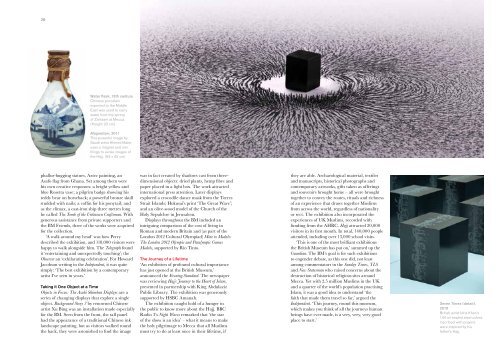12Review - British Museum
12Review - British Museum
12Review - British Museum
Create successful ePaper yourself
Turn your PDF publications into a flip-book with our unique Google optimized e-Paper software.
28 29<br />
Water flask, 19th century<br />
Chinese porcelain<br />
exported to the Middle<br />
East was used to carry<br />
water from the spring<br />
of Zamzam at Mecca.<br />
(Height 23 cm)<br />
Magnetism, 2011<br />
This powerful image by<br />
Saudi artist Ahmed Mater<br />
uses a magnet and iron<br />
filings to evoke images of<br />
the Hajj. (63 x 42 cm)<br />
phallus-hugging statues, Aztec painting, an<br />
Asafo flag from Ghana. Set among them were<br />
his own creative responses: a bright yellow and<br />
blue Rosetta vase; a pilgrim badge showing his<br />
teddy bear on horseback; a powerful bronze skull<br />
studded with nails; a coffin for his ponytail; and<br />
as the climax, a cast-iron ship three metres long<br />
he called The Tomb of the Unknown Craftsman. With<br />
generous assistance from private supporters and<br />
the BM Friends, three of the works were acquired<br />
for the collection.<br />
‘A walk around my head’ was how Perry<br />
described the exhibition, and 118,000 visitors were<br />
happy to walk alongside him. The Telegraph found<br />
it ‘entertaining and unexpectedly touching’; the<br />
Observer an ‘exhilarating celebration’. For Howard<br />
Jacobson writing in the Independent, it was quite<br />
simply: ‘The best exhibition by a contemporary<br />
artist I’ve seen in years.’<br />
Taking it One Object at a Time<br />
Objects in Focus: The Asahi Shimbun Displays are a<br />
series of changing displays that explore a single<br />
object. Background Story 7 by renowned Chinese<br />
artist Xu Bing was an installation made especially<br />
for the BM. Seen from the front, the tall panel<br />
had the appearance of a traditional Chinese ink<br />
landscape painting, but as visitors walked round<br />
the back, they were astonished to find the image<br />
was in fact created by shadows cast from threedimensional<br />
objects: dried plants, hemp fibre and<br />
paper placed in a light box. The work attracted<br />
international press attention. Later displays<br />
explored a crocodile dance mask from the Torres<br />
Strait Islands; Hokusai’s print ‘The Great Wave’;<br />
and an olive-wood model of the Church of the<br />
Holy Sepulchre in Jerusalem.<br />
Displays throughout the BM included an<br />
intriguing comparison of the cost of living in<br />
Roman and modern Britain and (as part of the<br />
London 2012 Cultural Olympiad) Mine to Medals:<br />
The London 2012 Olympic and Paralympic Games<br />
Medals, supported by Rio Tinto.<br />
The Journey of a Lifetime<br />
‘An exhibition of profound cultural importance<br />
has just opened at the <strong>British</strong> <strong>Museum</strong>,’<br />
announced the Evening Standard. The newspaper<br />
was reviewing Hajj: Journey to the Heart of Islam,<br />
presented in partnership with King Abdulaziz<br />
Public Library. The exhibition was generously<br />
supported by HSBC Amanah.<br />
The exhibition caught hold of a hunger in<br />
the public to know more about the Hajj. BBC<br />
Radio 3’s Night Waves remarked that ‘the star<br />
of the show is an idea’ – what it means to make<br />
the holy pilgrimage to Mecca that all Muslims<br />
must try to do at least once in their lifetime, if<br />
they are able. Archaeological material, textiles<br />
and manuscripts, historical photographs and<br />
contemporary artworks, gifts taken as offerings<br />
and souvenirs brought home – all were brought<br />
together to convey the routes, rituals and richness<br />
of an experience that draws together Muslims<br />
from across the world, regardless of nationality<br />
or sect. The exhibition also incorporated the<br />
experiences of UK Muslims, recorded with<br />
funding from the AHRC. Hajj attracted 20,000<br />
visitors in its first month. In total, 140,000 people<br />
attended, including over 13,000 school visits.<br />
‘This is one of the most brilliant exhibitions<br />
the <strong>British</strong> <strong>Museum</strong> has put on,’ summed up the<br />
Guardian. The BM’s goal is for such exhibitions<br />
to engender debate, as this one did, not least<br />
among commentators in the Sunday Times, TLS<br />
and New Statesman who raised concerns about the<br />
destruction of historical religious sites around<br />
Mecca. Yet with 2.5 million Muslims in the UK<br />
and a quarter of the world’s population practising<br />
Islam, it was a good idea to understand ‘the<br />
faith that made them travel so far,’ argued the<br />
Independent. ‘This journey, round this museum,<br />
which makes you think of all the journeys human<br />
beings have ever made, is a very, very, very good<br />
place to start.’<br />
Seven Times (detail),<br />
2010<br />
<strong>British</strong> artist Idris Khan’s<br />
144 oil-sealed steel cubes<br />
inscribed with prayers<br />
were inspired by his<br />
father’s Hajj.

















